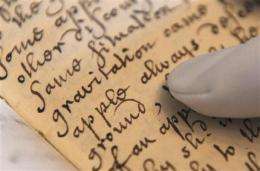Story of Newton's encounter with apple goes online

(AP) -- It always falls down. That's how the apple helped Isaac Newton.
An 18th-century account of how Newton developed the theory of gravity was posted to the Web Monday, making the fragile paper manuscript widely available to the public for the first time.
Newton's encounter with the apple ranks among science's most celebrated anecdotes, and it can now be read in the faded cursive script in which it was recorded by William Stukeley, Newton's contemporary.
Royal Society librarian Keith Moore said the apple story has resonated for centuries because it packs in so much - an illustration of how modern science works, an implicit reference to the solar system and even an allusion to the Bible.
When Newton describes the process of observing a falling apple and guessing at the principle behind it "he's talking about the scientific method," Moore said.
"Also the shape of the apple recalls the planet - it's round - and of course the apple falling from the tree does indeed hark back to the story of Adam and Eve, and Newton as a religious man would have found that quite apt."
The incident occurred in the mid-1660s, when Newton retreated to his family home in northern England after an outbreak of the plague closed the University of Cambridge, where he had been studying.
Stukeley's manuscript recounts a spring afternoon in 1726 when the famous scientist shared the story over tea "under the shade of some apple trees."
Stukeley wrote that Newton told him the notion of gravity popped into the scientist's mind as he was sitting in the same situation.
"It was occasion'd by the fall of an apple, as he sat in contemplative mood. Why should that apple always descend perpendicularly to the ground, thought he to himself ... Why should it not go sideways, or upwards? But constantly to the earth's center?" Stukeley wrote. "Assuredly, the reason is, that the earth draws it. There must be a drawing power in matter."
Stukeley's account on the Royal Society's Web site joins notes from Newton's 17th-century scientific rival Robert Hooke - documents that were lost for several hundred years before their recent discovery in a house in England.
Users can flip through both documents using the same page-turning software used to browse Leonardo's sketches and Jane Austen's early work on the British Library's site.
The Royal Society, an academy of scientists founded in 1660 to discuss and spread scientific knowledge, is marking its 350th anniversary this year by putting more than 60 of its most important scientific papers online.
More information: http://www.royalsociety.org/turning-the-pages
©2010 The Associated Press. All rights reserved. This material may not be published, broadcast, rewritten or redistributed.
















